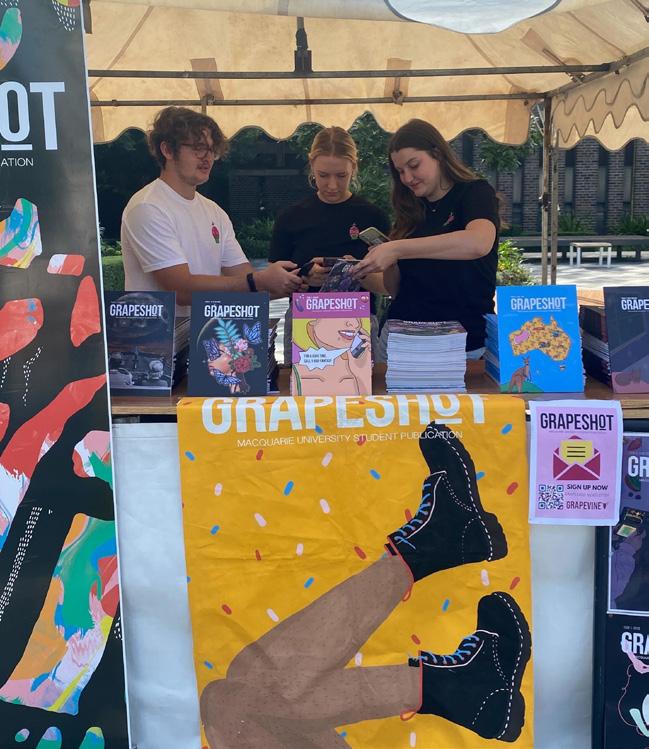
3 minute read
BIMBOFICATION: HYPERFEMININITY AND ITS WAR WITH FEMINISM

Sophie Poredos unpacks the social and cultural implications of hyperfemininity, investigating recent social media trends and her own experiences with femininity to illuminate the powerful agency of “bimboism,” as well as its offensive connotations.
Advertisement
Hyperfemininity has a track record of being demonized by Hollywood media. With its dangerous connotations of female expression and reclamation of sexual autonomy, this goes against the patriarchal grain. Indulging in femininity is synonymous with weakness: the societal rejection of all things pink reflects the battle of internalised misogyny faced by women.

Growing up as a young teen, my once favourite Barbie movies and Taylor Swift albums became too “embarrassing” for me to consume. When investigating the media rhetoric in which the “cool girl” was in (Gone Girl has a fantastic monologue of this) and the “girly girl” was out, I began to delve into a masculine world to differentiate myself as “not like other girls.”
It’s only within the last few years I’ve begun to rejoice in aspects of femininity that bring me joy. While gender is a social construct and the idea of femininity itself is misleading, I now participate vigorously in “womanhood” through bonding over rom-coms, fashion trends and drunk-girl bathroom talk™. Some may argue that this is performing for the male gaze. By participating in traditionally gendered roles, I am therefore contributing to the stereotypes of a woman being associated with a feminine sphere.

However, I present the idea of a “new age bimbo” who is more than just the idea of acting feminine for male attention. Via bimbofication one becomes simultaneously “stupid and hot” [1] as well as woke on all things social justice related, according to self-proclaimed Tiktok Bimbo Chrissy Chalpecka. This identity has everything to do with embracing a hyper-feminine persona of yourself. Think bold outfit pieces: pink and sequins, Juicy Couture sweatpants with matching sunglasses and a sparkly lippy to top it off. It’s important to recognize that this style’s influence of
90s and Y2K origins all take significant appropriation from the Black and Latino communities in America.
Through hyper-femininity, the expression of the feminine, playful side that women and non-binary people have been trying to hide can be explored in a multitude of fashion and lifestyle choices. A massive “fuck you” to the ridiculous and often contradictory beauty advice we may have all grown up with.


This hyperfeminine sphere presents an emerging discourse with feminism – does sexualising yourself perpetuate sexual stereotypes for other women? Is this purposeful blondie act resulting in an assumed promiscuity of all women who enjoy the bimbo lifestyle? Certain traits within this trend to act naïve and ditzy certainly feeds into the toxic idea of a “submissive” woman and fuel the expectation of men assuming dominant roles.

When I first began this article, I had a great bias against the effect of bimbofication and its emerging discourse with feminism. Through hyper-femininity, this exaggeration of the self can be communicated as a sexual image that may perpetuate sexual stereotypes about other women. What begins as a harmless movement of sexual liberation and empowerment may assert a stereotype of promiscuity for those who engage in a level of hyper-femininity. Chrissy herself has come under fire for her “baby voice” as this does contribute to the gross infantilization of women and the perception of women as sexual objects. [2]
So where do we draw the line between sexual liberation and unconsciously exploiting impressionable teens? Hyperfemininity and bimbofication undoubtedly have an important role in modern feminism; it positions people in an uncomfortable sphere of acknowledging their own biases for women who dress freely and embrace their sexual autonomy. However this movement appears to lack inclusivity for traditionally over-sexualised groups such as Black women, as commented by Tiktok user @oumousolo “We’re already hypersexualized, we’re already demonized, we’re already masculinized. We don’t have the same infantilization that white women have.” [2]
In 2023, it’s time to embrace the ethos of being a bimbo: “less thoughts, more vibes.” [2]




But only when bimbofication reaches a level of inclusivity and expression for all women and non-binary individuals that doesn’t undermine the image of others. Also preferably, without the baby voice.
by Sophie Poredos
[1] The age of Tiktok feminism.”, Mashable, 20th February 2023, https://mashable.com/article/tiktok-feminism-malegaze.
[2] This year I’m becoming a full-on bimbo – it’s better to be stupid and hot.” The Guardian, 20th February 2023, https:// www.theguardian.com/commentisfree/2022/jan/20/thisyear-im-becoming-a-full-on-bimbo-its-better-to-be-stupidand-hot.










